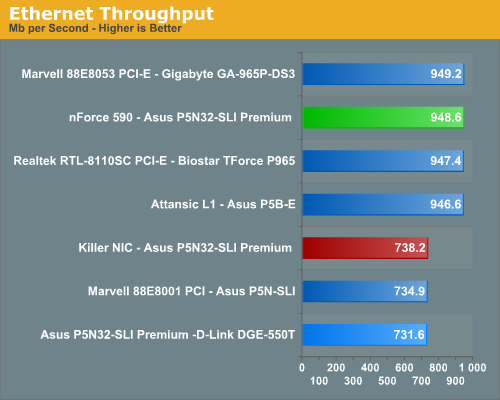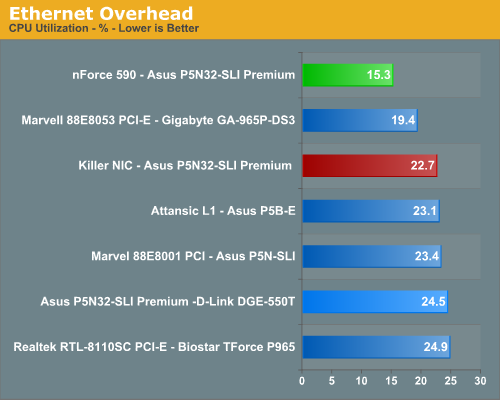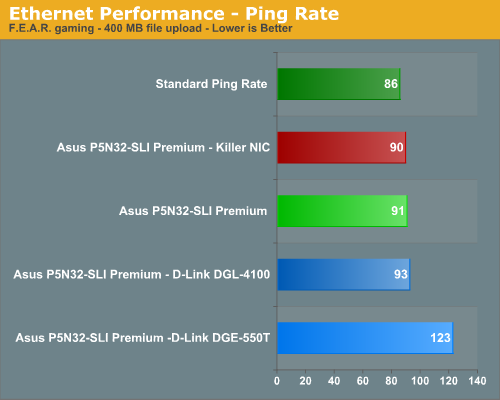BigFoot Networks Killer NIC: Killer Marketing or Killer Product?
by Gary Key on October 31, 2006 2:00 AM EST- Posted in
- Networking
Ethernet NIC Performance
Our current motherboard test suite includes LAN performance measurements and we will utilize this same test today. All of the boards listed utilize PCI or PCI Express based controllers with the only difference being the supplier of the core logic.
The Windows 2000 Driver Development Kit (DDK) includes a useful LAN testing utility called NTttcp. We used the NTttcp tool to test Ethernet throughput and the CPU utilization of the various Ethernet Controllers used on the Intel motherboards.
We set up one machine as the server; in this test, an Intel system with an Intel CSA Gigabit LAN connection. Intel CSA has a reputation for providing fast throughput and is a logical choice for our Gigabit LAN server.
On the server side, we used the following Command Line as suggested by the VIA whitepaper on LAN testing:


No real surprises here as the Killer NIC has a Marvell PHY and utilizes the PCI interface for operation. The throughput rates and CPU utilization of the Killer NIC was very competitive with our other PCI based solutions. However, the NVIDIA nForce 590SLI had the best overall performance numbers in these tests. BigFoot Networks was adamant about the fact they concentrated on lower latency and not improving throughput on the card since most network connections while gaming will not saturate the PCI bus.
Ethernet Outbound Ping Performance
Our final benchmark takes a look at the ping performance of each of our products while playing F.E.A.R. and uploading a 400 MB file to a separate client on another network. Our D-Link DGL-4100 router and the NVIDIA nForce 590SLI include packet prioritization for outbound traffic while gaming. We decided to see how well these solutions stacked up with the Killer NIC that can also prioritize inbound traffic.

All three of our products that advertise packet prioritization are within 3% of each other in the numbers with our D-Link DGE-550T trailing by around 33%. Why a serious gamer would actually want to upload large files while playing online is beyond us but in case you want to then our three solutions provide the capability to do so without an issue. However, be aware that throughput suffered by an average of 44% for the upload file test with our three solutions when compared to the D-Link NIC during testing.
Our current motherboard test suite includes LAN performance measurements and we will utilize this same test today. All of the boards listed utilize PCI or PCI Express based controllers with the only difference being the supplier of the core logic.
The Windows 2000 Driver Development Kit (DDK) includes a useful LAN testing utility called NTttcp. We used the NTttcp tool to test Ethernet throughput and the CPU utilization of the various Ethernet Controllers used on the Intel motherboards.
We set up one machine as the server; in this test, an Intel system with an Intel CSA Gigabit LAN connection. Intel CSA has a reputation for providing fast throughput and is a logical choice for our Gigabit LAN server.
On the server side, we used the following Command Line as suggested by the VIA whitepaper on LAN testing:
Ntttcpr -m 4,0,‹server IP› -a 4 -l 256000 -n 30000
On the client side (the motherboard under test), we used the following Command Line:Ntttcps -m 4,0,‹client IP› -a 4 -l 256000 -n 30000
At the conclusion of the test, we captured the throughput and CPU utilization figures from the client screen.

No real surprises here as the Killer NIC has a Marvell PHY and utilizes the PCI interface for operation. The throughput rates and CPU utilization of the Killer NIC was very competitive with our other PCI based solutions. However, the NVIDIA nForce 590SLI had the best overall performance numbers in these tests. BigFoot Networks was adamant about the fact they concentrated on lower latency and not improving throughput on the card since most network connections while gaming will not saturate the PCI bus.
Ethernet Outbound Ping Performance
Our final benchmark takes a look at the ping performance of each of our products while playing F.E.A.R. and uploading a 400 MB file to a separate client on another network. Our D-Link DGL-4100 router and the NVIDIA nForce 590SLI include packet prioritization for outbound traffic while gaming. We decided to see how well these solutions stacked up with the Killer NIC that can also prioritize inbound traffic.

All three of our products that advertise packet prioritization are within 3% of each other in the numbers with our D-Link DGE-550T trailing by around 33%. Why a serious gamer would actually want to upload large files while playing online is beyond us but in case you want to then our three solutions provide the capability to do so without an issue. However, be aware that throughput suffered by an average of 44% for the upload file test with our three solutions when compared to the D-Link NIC during testing.










87 Comments
View All Comments
Gary Key - Tuesday, October 31, 2006 - link
I fully agree the article was probably too long. It was a case of trying to cover all the bases and then some. If we had left out the technology sections and reduced the commentary it would have read better as a basic hardware item. We looked at this as not being your basic NIC review.However, I am sure there would have been comments that we did not properly review the card or provide this same information. Thanks for the comments.
Crassus - Wednesday, November 1, 2006 - link
I agree with the comment above. I would have like an even more expanded page detailing the technology and the roots in the corporate sector. What I didn't really care about was the endless description of the pains it took to benchmark the card.Two things about that:
1. If it was easy, everyone could do it. You (and Anandtech) stand above the crowd for going the extra mile and giving us some added (useful) information. This is usually self-evident and doesn't require elaboration.
2. My firm expects me to get the job done, as, I suppose, it is the same with yours. No one gives a hoot as to all the steps I had to go through to get the job done, unless they offer some added value. Thinking about throwing something out of the window (if you're blessed with having one in your office) occurs to everyone at some point and certainly doesn't hold any additional value - in other words: it comes with the job. If it was otherwise, see (1) above. There's really no need to mention it a couple of times - unless you're reviewing your work instead of the product.
Gary Key - Wednesday, November 1, 2006 - link
I appreciate your comments. I am alawys open to other viewpoints and opinions. What paragraphs contained endless descriptions that in your opinion could have been cut? Email me if you can please.
I agree it comes with the job. The message I was trying to convey was one of total frustration with the product after six weeks of almost non-stop testing. There were several choice words I wanted to use but felt like that statement would be universally understood. ;-)
Sunrise089 - Tuesday, October 31, 2006 - link
I really liked reading the article. When G80 comes out, we can cut strait to the benches, because I'm going to want to know whether or not to buy the card. None of us are going to buy this thing, but we're all enthusiests, so reading about it can still be fun. With performance changes so minor however, adding a little commentrary to spice up the review makes it a lot more entertaining for this reader.Frumious1 - Tuesday, October 31, 2006 - link
I'm in agreement with Sunrise - liked the article and the sarcasm. I can only imagine your pain during the review. Can't believe how many people apparently lack the ability to read and need pictures. "Just give us two paragraphs saying whether or not to buy the card!" Bah! That's what the conclusion page is for, where it's pretty clear the card "works as advertised" which means fractional gains in a few games.Zaitsev - Tuesday, October 31, 2006 - link
"Just give us two paragraphs saying whether or not to buy the card!"The only reason I still read Anandtech is because they do exactly the opposite. In articles like this one and the Conroe review, I think the pages discussing the technology are more interesting than the results. I can't talk from experience, but it also seems that it would get boring for the authors if they just punched out cookie cutter articles for every review.
As for the card, I wouldn't be able to sleep at night if I bought this instead of a Conroe.
michal1980 - Tuesday, October 31, 2006 - link
i can sum in up for you in one line."In most cases the Killer-Nic Does Nothing"
as for windows vista.
it has a total new audio stack that is seperate from the kenernal, so in theory it could run on a core other then the main os kerenal.
Googer - Tuesday, October 31, 2006 - link
FNA is the only thing that makes a killer nic really worthwhile.http://www.extremetech.com/article2/0,1697,2037279...">http://www.extremetech.com/article2/0,1697,2037279...
cryptonomicon - Tuesday, October 31, 2006 - link
Assuming the review quantified "ping measurements" correctly, this thing has a long way to go. If it gave even a consistent 10% faster pings all the time it would be very appealing to pro-gaming. But from those ping charts, the results were truely inconclusive. The side effect of increased FPS was even more significant than any ping reduction.Looking forward to revisions or later models from Bigfoot though!
floffe - Tuesday, October 31, 2006 - link
That's because in most cases 98% of the ping is not on the local computer, but from your internet connection point (DSL/cable modem or whatever) to the server. Tis means even cutting 5% off that will be very hard (in general. WoW seems to be an exception).